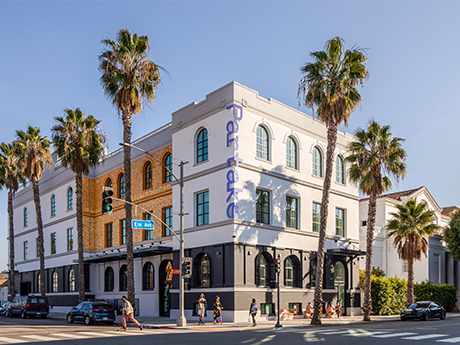— By Elise Kunihiro and Maura Schafer —
Historic building adaptive reuse creates a bridge between the past and the future, resulting in places that can become the hearts and souls of their communities. The reuse of these buildings offers community benefits, such as sustainability, new public spaces and character.
Reactivate local economies
Beyond revitalizing older buildings, adaptive reuse projects can also support small local business owners. A 1922 brick office building in the East Village Arts District of downtown Long Beach, Calif., for example, now hosts Partake Collective. The 25,000-square-foot cloud concept and food hall incubator allows visitors to support local restauranteurs while dining in a communal food hall or sidewalk dining area.
Studio One Eleven served as the project’s architect, while RDC did interiors and procurement. The goal of this redevelopment model was to create a benchmark for future development that celebrates food diversity and enhances community building. It doesn’t hurt that Partake Collective remains an active and engaged member of the Long Beach community by working with local educational institutions to support pathways to private enterprise, business ownership and job opportunities for the most underrepresented communities. Partake Collective has already partnered with culinary programs at Browning High School, California State University Institute for Innovation and Entrepreneurship and Long Beach City College to support students’ passion for the culinary arts.
Restore a landmark with placemaking, new resources
Nobody benefits from long-vacant retail buildings—and it can be tempting to tear down and rebuild on well-located sites. Yet, historic architecture can offer even greater economic and community-building opportunities than a new facility would, even beyond the inherent design and environmental benefits of restoring a classic destination.
When Erewhon was looking to expand into their tenth Los Angeles-area location, its team saw potential in Pasadena’s I. Magnin & Company Building. Located at 475 South Lake Ave., the building had been vacant for more than 10 years.
RDC used 3D technology to scan the building, documenting the historic architectural details and technical specifications of its construction. We then restored and preserved the building’s original architectural features by removing various facade elements that were added over the years. This included the removal of entrance awnings and planted-on show windows, while restoring the existing large wood-framed windows.
The owners made a considerable investment in reclaiming the historic exterior appearance and upgrading the plumbing, electrical and mechanical systems. The roof was also replaced to meet modern sustainability goals.
Bringing a buzzy health food grocer into this historic space not only provided the neighborhood with much-needed resources, but restored a sense of glamour to the building and area. The revitalization of the property activated the areas surrounding the building with upgraded amenities, hardscape, landscape and generous outdoor spaces with seating at the pedestrian level. Erewhon occupies space on the ground floor and basement. The second floor houses Brella, an app-enabled childcare center, and Tia, an integrated women’s healthcare clinic, both of which opened in 2023.
The ROI on a revitalized building can be partially measured by its existing vibrancy. From morning until evening, the I. Magnin & Company Building bustles with Erewhon customers, patients seeking services at Tia and parents (and kids) dropping off and picking up at Brella.
Adapting and reusing historic properties can deliver clear and tangible economic benefits—but that’s only part of the story. To fully realize the potential of a historic property, its owners and architects must create community value through the addition of public gathering spaces, the transformation of tired, unkept exteriors, and real neighborhood economic development through the businesses and services that occupy the restored property.
Elise Kunihiro is senior job captain and Maura Schafer is chief marketing officer at RDC, an architecture firm in Long Beach, Calif.


